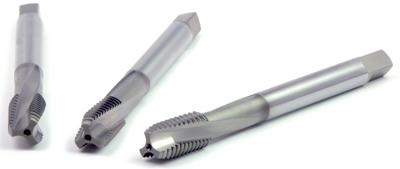
OSG Tap & Die Inc. introduced the EXOPRO-WHR-Ni spiral flute and spiral point tap series, designed to excel in nickel-based alloy applications.
Nickel-based heat resistant alloys are materials with extremely poor machinability. Short tool life, sudden tool wear, breakage and chipping at the chamfer are common problems associated with the machining of these materials. To accommodate new industry demand, OSG has developed a total solution for threading nickel alloys with the EXOPRO-WHR-Ni tap series.
The EXOPRO-WHR-Ni spiral flute tap features a new point flute design to improve cutting edge rigidity, which helps prevent chipping and enables it to excel even in blind holes.
The EXOPRO-WHR-Ni spiral point tap, designed for blind hole applications, features a unique rake angle to protect against sudden tool wear. With the addition of OSG's patented HR coating, tool life can be substantially prolonged, according to the company.
Contact Details
Related Glossary Terms
- Rockwell hardness number ( HR)
Rockwell hardness number ( HR)
Number derived from the net increase in the depth of impression as the load on the indenter is increased from a fixed minor load to a major load and then returned to the minor load. The Rockwell hardness number is always quoted with a scale symbol representing the indenter, load and dial used. Rockwell A scale is used in connection with carbide cutting tools. Rockwell B and C scales are used in connection with workpiece materials.
- alloys
alloys
Substances having metallic properties and being composed of two or more chemical elements of which at least one is a metal.
- machinability
machinability
The relative ease of machining metals and alloys.
- rake
rake
Angle of inclination between the face of the cutting tool and the workpiece. If the face of the tool lies in a plane through the axis of the workpiece, the tool is said to have a neutral, or zero, rake. If the inclination of the tool face makes the cutting edge more acute than when the rake angle is zero, the rake is positive. If the inclination of the tool face makes the cutting edge less acute or more blunt than when the rake angle is zero, the rake is negative.
- tap
tap
Cylindrical tool that cuts internal threads and has flutes to remove chips and carry tapping fluid to the point of cut. Normally used on a drill press or tapping machine but also may be operated manually. See tapping.
- threading
threading
Process of both external (e.g., thread milling) and internal (e.g., tapping, thread milling) cutting, turning and rolling of threads into particular material. Standardized specifications are available to determine the desired results of the threading process. Numerous thread-series designations are written for specific applications. Threading often is performed on a lathe. Specifications such as thread height are critical in determining the strength of the threads. The material used is taken into consideration in determining the expected results of any particular application for that threaded piece. In external threading, a calculated depth is required as well as a particular angle to the cut. To perform internal threading, the exact diameter to bore the hole is critical before threading. The threads are distinguished from one another by the amount of tolerance and/or allowance that is specified. See turning.

